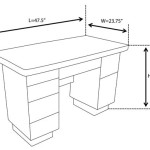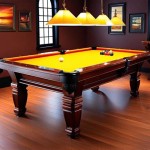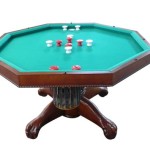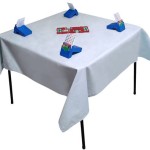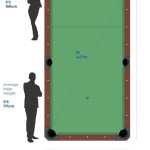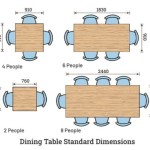Determining Seating Capacity for a 60 Inch Round Table
A 60-inch round table is a popular choice for dining rooms, event venues, and conference spaces. Its circular shape encourages conversation and creates a visually appealing focal point. However, accurately determining the appropriate seating capacity for a 60-inch round table is crucial for ensuring both comfort and functionality. Overcrowding can lead to an unpleasant dining or meeting experience, while underutilizing the space may result in an inefficient layout. Several factors influence the optimal number of seats, including the type of seating, the intended use of the table, and the desired level of personal space.
This article will delve into the key considerations for determining the appropriate seating capacity for a 60-inch round table. It will explore the standard guidelines, discuss the impact of various seating options, and provide practical advice for maximizing comfort and usability. By understanding these principles, individuals and organizations can make informed decisions about table arrangements and create a more positive and productive environment.
Understanding Standard Seating Guidelines
The generally accepted guideline for seating at a round table is based on providing adequate personal space for each individual. A comfortable dining experience requires sufficient elbow room and space for movement. Industry standards typically allocate approximately 24 inches of space per person at a round table. This measurement refers to the arc length of the table’s circumference that each seat occupies. Applying this standard to a 60-inch round table allows for a relatively straightforward calculation of its potential seating capacity.
To determine the ideal number of chairs, one can calculate the circumference of the table using the formula C = πd, where C is the circumference, π (pi) is approximately 3.14159, and d is the diameter. In this case, the diameter is 60 inches. Therefore, the circumference of a 60-inch round table is approximately 188.5 inches (3.14159 x 60). Dividing this circumference by the standard 24 inches per person yields an approximate seating capacity of 7.85. Since one cannot have a fraction of a chair, the practical seating capacity, using the 24-inch rule, is typically considered to be 7 to 8 people.
However, it is important to recognize that this calculation provides a general guideline. The actual comfortable seating capacity may vary depending on the specific characteristics of the chairs and the overall atmosphere desired. Using chairs with arms, for instance, will require more lateral space, potentially reducing the number of comfortably accommodated guests. Similarly, if a more spacious and relaxed setting is preferred, limiting the seating to 6 or 7 people might be more suitable.
These standard guidelines also assume that the table will be used for activities where individual space is important, such as dining or working. In scenarios where close collaboration or casual interaction is prioritized, a slightly higher number of seats might be acceptable, although comfort should always remain a primary consideration.
The Influence of Seating Choices on Capacity
The type of seating used significantly affects the perceived and actual space available at a 60-inch round table. Chairs with arms, as mentioned previously, introduce an additional constraint on space. The width of the arms extends the overall footprint of each seat, thereby requiring a larger arc length on the table's circumference. Using armless chairs, on the other hand, can maximize seating capacity within the same physical space.
Folding chairs generally offer a compact design and a smaller footprint compared to more elaborate dining chairs. These are often used for events where maximizing seating is a primary concern, although comfort levels might be lower. If folding chairs are selected, it is advisable to ensure that they provide adequate back support and a comfortable seat cushion for extended use. Even with their space-saving design, adhering to the 24-inch per person guideline remains beneficial for preventing overcrowding.
Booth-style seating, while less common around a circular table, presents another scenario. If a custom-built, curved booth is designed to surround a portion of the table, the seating capacity and spatial dynamics will change significantly. This type of arrangement often provides a more intimate and enclosed setting, potentially allowing for slightly more seating than individual chairs. However, the design of the booth itself must be carefully considered to ensure that individuals can easily enter and exit the seating area without disrupting others.
Furthermore, the depth of the chairs should be considered. Chairs with deeper seats will require occupants to sit further away from the table's edge, potentially impacting their comfort and ability to easily reach items placed in the center. Therefore, selecting chairs with an appropriate seat depth is crucial for ensuring optimal ergonomics and functionality.
The height of the chairs relative to the table is another important factor. If the chairs are too low, individuals may feel uncomfortable reaching for food or engaging in conversation. Conversely, chairs that are too high can create an awkward and unstable seating experience. It is generally recommended to maintain approximately 12 inches between the top of the chair seat and the underside of the table. This height difference allows for comfortable legroom and ensures that individuals can easily interact with the table's surface.
Optimizing Comfort and Usability
Beyond the numerical calculations of seating capacity, several practical considerations can enhance the comfort and usability of a 60-inch round table. The placement of the table within the room is a crucial factor. Adequate space should be provided around the table to allow for easy movement and access. A minimum of 36 inches of clearance between the table's edge and any walls or obstacles is generally recommended. This clearance allows individuals to comfortably pull out their chairs and navigate around the table without bumping into anything.
The intended use of the table will also influence the optimal seating arrangement. For dining purposes, sufficient space should be provided for tableware, glassware, and serving dishes. If the table is being used for a meeting or conference, consider the need for notebooks, laptops, and other materials. In these scenarios, strategically placing place settings or providing additional side tables can help to maximize usable space and prevent clutter.
The presence of a centerpiece can also impact seating comfort. A large or bulky centerpiece can obstruct views and make it difficult for individuals to converse across the table. Selecting a smaller, lower centerpiece or opting for multiple smaller arrangements can minimize these disruptions. The height of the centerpiece should also be considered to ensure that it does not interfere with visual communication among seated individuals.
Lighting can also impact the overall seating experience. Adequate and well-positioned lighting can enhance visibility and create a more inviting atmosphere. Dimly lit environments can make it difficult to see and interact with others, while overly bright lighting can be harsh and uncomfortable. Selecting appropriate lighting fixtures and adjusting the brightness levels can significantly improve the ambiance and functionality of the seating area.
Finally, considering the demographic of the users is important. If the table is frequently used by elderly individuals or people with mobility impairments, ensuring easy access and comfortable seating is paramount. Providing chairs with supportive backs and armrests can enhance comfort and reduce the risk of discomfort or injury. Similarly, ensuring that the table height is appropriate for individuals of varying heights can promote a more inclusive and accommodating environment.
By incorporating these considerations into the decision-making process, individuals and organizations can create a more welcoming, comfortable, and functional seating arrangement around a 60-inch round table.

Professional Table Seating Guide The Chiavari Chair Company

60 Round Table Seat 8 To 10 Destination Events

60 Round Table Seats 8 Tent Party Events

60 Round Table Seat 8 To 10 Destination Events

60 Round Table Seats 6 8 Mimi S Party Palace Llc

5 60 Tables 30 Chairs

Lifetime 60 Inch Round Table And 8 Chairs Combo

60 In Round Table Mtb Event Als

60 Round Table Facade Theme Party

Round 60 Inch Party Table Al Seats Up To 10 S
Related Posts

